Faunal remains, which often occur as one the major constituents of a shell-midden deposit, are indispensable to the study of man's relationship to his environment. Detailed analysis of such materials can provide the prehistorian with significant data for interpretations concerning prehistoric subsitence activities.
Faunal remains, except molluscan shells, were collected completely from all areas of the present excavation. Their quantity was large. Laboratory analysis of this material is still in progress and permits only limited conclusions.
Identified Species
1) Molluscan Remains
As the name shell-midden site indicates, molluscan shells are the most important constituent in the cultural layers. In the case of the present site, Layers A, B, C and E yielded large quantities of shells. These shells consist of one genus and ten species of gastropods, one species of scaphopods and thirteen species of pelecypods. The shells were identified by Prof. M. Horikoshi.
(a)Gastropoda
- Haliotis sp.
- Japanese name: Mimigai
- Represented by one fragmentary shell artifact tentatively identified as the inner, nacreous part of an abalone shell (Fig. 13:32, Plate XIX: 28). Some living forms of this genus are found on the rocky bottoms from tidal zones to the upper sublittoral depths on the open sea coast along the central part of the main Japanese Island of Honshu.

Figure 13: Shell artifacts. Bracelets (1-26,28), spatulas (27,31), worked pieces (29, 30) and perforated piece (32) (Scale 1/2).
1 (K-84); Bracelet (fragment). From layer B. Material, Anadara satowi nipponensis (Plate XIX:5).
2 (K-109); Bracelet (fragment). From layer E. Material, Anadara satowi nipponensis (Plate XIX: 2).
3 (K-104); Bracelet (fragment). From layer E. Material, Anadara satowi nipponensis (Plate XIX:3).
4 (K-111); Bracelet. From layer E. Material, Anadara satowi nipponensis (Plate XIX:4).
5 (K-108); Bracelet (fragment). From layer E. Material, Anadara satowi nipponensis (Plate XIX: 10).
6 (K-81); Bracelet (fragment). From layer B. Material, Anadara satowi nipponensis (Plate XIX:22).
7 (K-90); Bracelet (fragment). From layer C. Material, Glycymeris albolineata (Plate XIX:8).
8 (K-91); Bracelet (fragment). From layer C. Material, possibly Glycymeris albolineata (Plate XIX: 23).
9 (K-86); Bracelet (fragment). From layer B. Material, Anadara satowi nipponensis (Plate XIX:27).
10 (K-87); Bracelet (fragment). From layer B. Material, Glycymeris albolineata (Plate XIX:16).
11 (K-95); Bracelet (fragment). From layer C. Material, Anadara Satowi nipponensis (Plate XIX: 13).
12 (K-103); Bracelet (fragment). From layer E. Material, Anadara satowi nipponensis (Plate XIX:19).
13 (K-94); Bracelet (fragment). From layer C. Material, Anadara satowi nipponensis (Plate XIX:26).
14 (K-93); Bracelet (fragment). From layer C. Material, Anadara satowi nipponensis (Plate XIX:7).
15 (K-102); Bracelet (fragment). From layer E. Material, Anadara satowi nipponensis (Plate XIX: 11).
16 (K-107); Bracelet (fragment). From layer E. Material, Anadara satowi nipponensis (Plate XIX:20).
17 (K-110); Bracelet (fragment). From layer E. Material, Anadara satowi nipponensis (Plate XIX:12).
18 (K-83); Bracelet (fragment). From layer B. Mateiral, Anadara satowi nipponensis (Plate XIX:15).
19 (K-88); Bracelet (fragment). From layer B. Material, Anadara satowi nipponensis (Plate XIX:24).
20 (K-112); Bracelet (fragment). From layer F. Material, Anadara satowi nipponensis (Plate XIX:6).
21 (K-82); Bracelet (fragment). From layer B. Material, Anadara satowi nipponensis (Plate XIX: 14).
22 (K-105); Bracelet (fragment). From layer E. Material, Anadara satowi nipponensis (Plate XIX:9).
23 (K-85); Bracelet (fragment). From layer B. Material, Anadara satowi nipponensis (Plate XIX:21).
24 (K-106); Bracelet (fragment). From layer E. Material, Anadara satowi nipponensis (Plate XIX:1).
25 (K-92); Bracelet (fragment). From layer C. Material, Glycymeris albolineata (Plate XIX:18).
26 (K-101); Bracelet (fragment). From layer D Material, Anadara satowi nipponensis (Plate XIX:25).
27 (K-96); Spatula. From layer C. Material, Meretrix lamarckli (Plate XIX:29).
28 (K-80); Bracelet (fragment). From layer B. Material, Glycmeris albolineata (Plate XIX:17).
29 (K-89); Worked piece. Polished edge of shell. From layer B. Material, Anadara satowi nipponensis (Plate XIX:32).
30 (K-99); Worked piece. Polished smooth, flat edge of shell, From layer C. Material, Meretrix lamarckii (Plate XIX:30).
31 (K-97); Spatula. From layer C. Marerial, Meretrix lamarckii (Plate XIX:31).
32 (K-98); Perforated piece. Thin section of pearl layer perforated at one end. From layer C. Material, Haliotis sp. (Plate XIX: 28). |
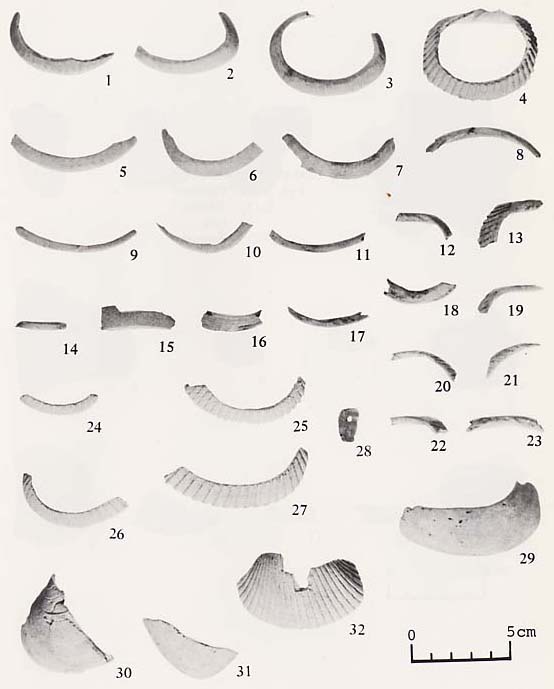
Plate XIX: Shell artifacts (Scale 1/2).
1-27; Bracelets,
28; Perforated piece,
29,31; Spatulas,
30,32; Worked piece |
- Pictoneritina oualaniensis (Lesson) (Plate V:6)
- Japanese name: Himekanoko
- The living individuals of the species are found in the tidal zones along the southern part of Honshu (Kii Peninsula).
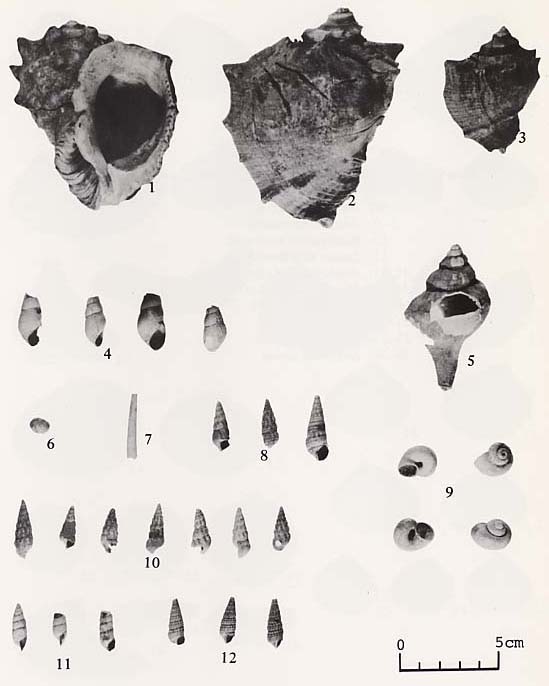
Plate V: Molluscan remains showing the following species (Scale 1/2).
1-3; Rapana thomasiana,
4; Semisulcospira bensoni japonica,
5; Neptunea arthritica,
6; Pictoneritina oualaniensis,
7; Antalis tibanum,
8; Batillaria multiformis,
9; Cyclophorus herklotsi,
10; Batillaria cumingii,
11; Mrus reiniana,
12; Cerithideopsilla djadjariensis |
- Cyclophorus herklotsi (V. Martens) (Plate V: 9)
- Japanese name: Yamatanishi
- This land snail lives under fallen leaves and is distributed throughout Honshu and Kyushu.
- Batillaria Multiformis (Lischke) (Plate V: 8)
- Japanese Name: Uminina
- The living individuals are found on sandy mud bottoms in intertidal zones throughout Honshu and Kyushu.
- Batillaria cumingii (Crosse) (Plate V:10)
- Japanese name: Hosouminina
- The living individuals of this species inhabit the sandy mud bottoms in tidal zones from Hokkaido to Kyushu.
- Semisulcospira bensoni japonica (Reeve) (Plate V:4)
- Japanese name: Misujikawanina
- The living individuals of the species inhabit rivers and lakes in southern Hokkaido and southward.
- Certithideopsilla djadjariensis (Martin) (Plate V:12)
- Japanese name: Kawaai
- The living individuals of this species inhabit muddy bottoms in the brackish water areas in the central and southern Japan.
- Rapana thomasiana (Crosse) (Plate V:1-3)
- Japanese name: Akanishi
- This species is the greatest in quantity of the gastropods and is found in all layers. It is especially common in Layer E. The living individuals of this species live on sand or mud bottoms in tidal and upper sublittoral (less than 20 m deep) zones in the areas from southern Hokkaido to Kyushu.
- Neptunea arthritica (Bernardi) (Plate V:5)
- Japanese name: Himeezobora
- The living individuals of this species inhabit the soft bottoms of upper sublittoral zones north of the cape of Choshi on the Pacific coast of Honshu.
- Mirus reiniana (Kobelt) (Plate V: 11)
- Japanese name: Kiserumodoki
- The living individuals of this species live on land and are distributed from southern Hokkaido to Kyushu.
- Euhadra quaesita (Deshayes)
- Japanese name: Hidarimakimaimai
- Represented by one fragment from Layer A. The living individuals of this species live on land among fallen leaves under shrubs.
(b) Scaphopoda
- Antalis tibanum (Nomura) (Plate V:7)
- Japanese name: Migakimarutsuno
- Represented by one piece from Layer E. The living individuals of this species are found on fine sand bottoms of 10-100 meters depth along the southern Boso Peninsula, Honshu.
(c) Pelecypoda
- Anadara satowi nipponensis (Pilsbry) (Plate VI: 12,13)
- Japanese name: Marusarubo
- Represented by a few pieces from each layer. Most are modified, especially to make bracelets (See Table 12). The living individuals are found on fine sandy, mud bottoms of 10-30 meters depth in Chubu, Kanto and Hokuriku regions.


Plate VI: Molluscan remains showing the following species (Scale 1/2)
1-4; Meretrix lusoria,
5; Meretrix lamarckii,
6-9; Anadara subcrenata,
10; Patinopecten yessoensis,
11; Spisula sachalinensis,
12,13; A nadara sato wi nipponensis,
14,15; Macoma contabulata,
16-19; Mactra veneriformis,
20-22; Cyclina orientalis,
23-25; Corbicula japonica,
26-28; Soletelline diphos |
- Anadara subcrenata (Lischke) (Plate VI: 6-9)
- Japanese name: Sarubo
- Represented by a few pieces in each layer. The living individuals of this species are found on sandy bottoms in tidal zones and sublittoral zones (less than 10 meters deep) in bays.
- Glycymeris(Veletuceta) albolineata (Lischke)
- Japanese name: Benkeigai
- The five pieces of this species are modified for various uses (See Table 12). The living individuals are found on fine sandy bottoms of 5-20 meters depth along the open coast from northern Honshu to Kyushu.
- Patinopecten yessoensis (Jay) (Plate VI: 10)
- Japanese name: Hotategai
- Represented by one fragment from Layer E. The living individuals of this species are found abundantly on gravelly or sandy bottoms of 10-30 meters depth in the Tohoku region of northeastern Honshu and in Hokkaido.
- Inversidens fapanensis (Lea)
- Japanese name: Matsukasagai
- The living individuals are found on gravelly or sandy bottoms in clear, fresh water environments throughout Japan.
- Corbicula japonica (Prime) (Plate VI: 23-25)
- Japanese name: Yamatoshijimi
- This species makes up more than 90% of the total shells found during the present excavation. It was probably the main source of shell fish used for food. The living individuals of this species are found in brackish water environments such as river mouths and estuaries in Japan.
- Meretrix lousoria (Röoding) (Plate VI: 1-4)
- Japanese name: Hamaguri
- This species is the second largest in quantity after Corbicula japonica. The living individuals of this species are distributed from southern Hokkaido to Kyushu and inhabit the sand or mud bottoms in tidal and sublittoral zones in bays and inland seas.
- Meretrix lamarckii (Deshayes) (Plate VI: 5)
- Japanese name: Chosenhamaguri
- Very low in quantity. Most of the collected examples are modified for some use (See Table 12). The habitat of the living individuals is different from that of Meretrix lusoria and is confined to sand bottoms in upper sublittoral zones facing the open sea.
- Cyclina orientalis (Sowerby) (Plate VI: 20-22)
- Japanese name: Okishijimi
- A few pieces were collected from each layer of the site. The living individuals of this species inhabit the muddy bottoms in tidal flats in bays throughout Honshu.
- Mactra veneriformis (Reeve) (Plate VI: 16-19)
- Japanese name: Shiofuki
- A few pieces were collected from each layer of the site. The living individuals of this species inhabit sandy mud bottoms in tidal flats in bays, and are distributed from the Kanto Region to Kyushu.
- Spisula sachalinensis (Schrenck) (Plate VI: 11)
- Japanese name: Ubagai (Hokkigai)
- Represented by one piece from Layer E. The living individuals of this species inhabit upper sublittoral, sand bottoms along open coasts and are distributed from Hokkaido to northern Honshu.
- Soletelline diphos (Linnée) (Plate VI: 26-28)
- Japanese name: Murasakigai
- The living individuals of this species are burrowers in mud bottoms in upper sublittoral zones less than 50 meters deep throughout Honshu and Kyushu.
- Macoma contabulata (Deshayes) (Plate VI: 14-15)
- Japanese name: Sabishiratorigai
- The living individuals of this species inhabit mud bottoms in tidal and upper sublittoral zones in bays throughout Honshu and Kyushu.
2) Remarks on the Molluscan Remains
The one genus and the 24 species of identified molluscs quantify according to habitat as follows: land - 3 spp., freshwater - 2 spp., brackish water - 2 spp., tidal zone - 5 spp., tidal-to upper sublittoral zones - 5 spp., upper sublittoral zone - 7 spp., upper-to lower sublittoral zones - 1 sp. In addition to these distinctions in habitat, a contrast can be made between bay and open coast environment and between riverine and lacustrine environments (Table 1).

Of the twenty-five identified species, three are land snails - Cyclophorus hereklotsi, Mirus reiniana and Enhadra quaesita. It can be assumed that these species lived within the midden deposits and were not collected by man. But the other twenty-two species were probably brought back to the site by the Kamitakatsu people for some definite purpose before being thrown away in the midden.
Of these other species, Corbicula japonica is greatest in quantity and represents over ninety percent of the total in layers with concentrations of shells. This species lives in a brackish water environment. Six other species are moderately common in all layers - Rapana thomasiana, Anadara subcrenata, Meretrix lusoria, Cyclina orientalis, Mactra veneriformis and Soletelline diphos. These species all live on mud or sandy mud bottoms in tidal and upper sublittoral zones (less than twenty meters deep) in bays. In short, most of the collected molluscs are species that live in the brackish water environment of tidal and upper sublittoral zones in bays. On the other hand, four species - Anadara satowi nipponensis, Glycymeris albolineata, Meretrix lamarckii and Spisula sachalinensis - live in the upper sublittoral zones along open coasts, a distinctly different ecological zone from that of the seven dominant species. Thus the majority of molluscan remains found during the present investigation fall into two groups according to habitat: a) those that inhabit brackish water environments in tidal and sublittoral zones in bays, and b) those which inhabit upper sublittoral zones along open coasts. The few fresh water shells - Semisulcospira bensoni japonica and Inversidens japanensis - can be included in the first group. Quantatively remains of the species in the former group are greatest. Remains of the species in the latter group are very low in number. It is interesting to find that many of Anadara satowi nipponensis, Glycymeris albolineata and Meretrix lamarckii shells (all from open sea habitats) are modified for use In some capacity such as bracelets.
3) Vertebral Remains
The number of bone fragments collected runs into the hundreds. The identifiable remains fall into three groups: fish, birds and mammals. The bird and mammalian remains were identified by Dr. Y. Hasegawa. The fish remains were identified by the author.
a) Fish (Table 2)
- Myliobatus tobijei (Bleeker)
- Four tail spines (Fig. 11: 24-27, Plate XVII: 24-27) used as spearheads.
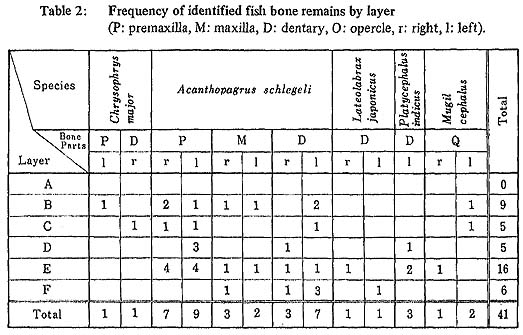

Figure 11: Bone and antler artifacts. Spearheads (1-27), tube (28), spatula (29), perforated pieces (30,31) and disk (32) (Scale 1/2).
1 (K-33); Spearhead (fragment). From layer B. Material, long bone of Cervus nippon (Plate XVII: 1).
2 (K-34); Spearhead (fragment). From layer B. Material, long bone of Cervus nippon (Plate XVII:2).
3 (K-32); Spearhead (fragment). From layer B. Material, long bone of Cervus nippon (Plate XVII:3).
4 (K-35); Spearhead (fragment). From layer B. Material, long bone of Cervus nippon (Plate XVII:4).
5 (K-47); Spearhead (fragment). From layer C. Material, unidentified (Plate XVII:5).
6 (K-40); Spearhead (fragment). From layer C. Material, unidentified (Plate XVII:6).
7 (K-38); Spearhead (fragment). From layer C. Material, antler of Cervus nippon (Plate XVII:7).
8 (K-41); Spearhead (fragment). From layer C. Material, unidentified (Plate XVIl:8).
9 (K-39); Spearhead (fragment). From layer C. Material unidentified (Plate XVII:9).
10 (k-100); Spearhead (fragment). From layer D. Material, unidentified (Plate XVII:10).
11 (K-53); Spearhead (fragment). From layer D. Material, long bone of Cervus nippon (Plate XVII: 11).
12 (K-54); Spearhead (fragment). From layer D. Material, long bone of Cervus nippon (Plate XVII:l2).
13 (K-19); Spearhead (fragment). From layer E. Material, long bone of Cervus nippon (Plate XVII: 13).
14 (K-60); Spearhead (fragment). From layer E. Material, long bone of Cervuc nippon (Plate XVII:21).
15 (K-58); Spearhead (fragment). From layer E. Material, long bone of Cervus nippon (Plate XVII: 22).
16 (K-57); Spearhead (fragment). From layer E. Material, long bone of Cervus nippon (Plate XVII:19).
17 (K-61); Spearhead (fragment). From layer E. Material, long bone of Cervus nippon (Plate XVII:17).
18 (K-64); Spearhead (fragment). From layer E, Material, long bone of Cervus nippon (Plate XVII: 18).
19 (K-73); Spearhead (fragment). From layer F. Material, long bone of Cervus nippon (Plate XVII:16).
20 (K-74); Spearhead (fragment). From layer F. Material, long bone of Cervus nippon (Plate XVII:20).
21 (K-77); Spearhead (fragment). From layer F. Material, long bone of Cervus nippon (Plate XVII:14).
22 (K-76); Spearhead (fragment). From layer F. Material, unidentified (Plate XVII:15).
23 (K-75); Spearhead (fragment). From layer F. Material, unidentified (Plate XVII:23).
24 (K-42); Spearhead (fragment). From layer C. Material, tail spine of Myliobatus tobijei (Plate XVII:24).
25 (K-69); Spearhead (fragment). From layer E. Material, tail spine of Myliobatus toblfei (Plate XVII:25).
26 (K-68); Spearhead (fragment). From layer E. Material, tail spine of Myliobatus tobijei (Plate XVII:26).
27 (K-67); Spearhead (fragment). From layer E. Material, tail spine of Myliobatus tobl/ei (Plate XVII: 27).
28 (K-36); Tube (fragment). Short hollow section of long bone shaft, with ends cut and polished smooth. From layer B. Material, long bone of Cervus nippon (Plate XVII:28).
29 (K-43); Spatula (fragment). Section of long bone split with dull edge at one end. Polished smooth. surfaces. From layer C. Material, long bone of Cervus nippon (Plate XVII:29).
30 (K-46); Perforated piece. Thin curved section of antler perforated at one end. Small hole drilled from both sides. Polished smooth surface. From layer C. Material, antler of Cervus nippon (Plate XVII:30).
31 (K-45); Perforated piece (fragment). Thin flat section of lower canine of Sus Scrofa. Small holl drilled from both sides. Polished smooth surfaces. From layer C (Plate XVII: 31).
32 (K-70); Disk. Polished opercle of Mugil cephalus. From layer E (Plate XVII:32). |

Plate XVII: Bone and antler artifacts (Scale 1/2).
1-27; Spearhead,
28; Tube,
29; Spatula,
30,31; Perforated piece,
32; Disk |
- Mugil cephalus (Linne)
- Three pieces of opercle bone (Plate VII: 15) with fan-shaped outlines; many fine radial lines are seen on the convex, upper surfaces.
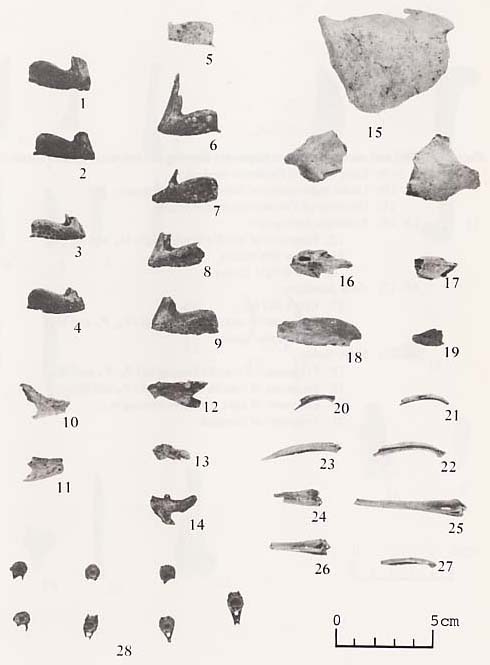
Plate VII: Fish bone fragments showing the following species (Scale 1/2).
1-14; Acanthopagrus schlegeli:
1-4; left premaxilla,
5-9; right premaxilla,
10-11; left dentary,
12-14; right dentary
15; Left opercle of Mugil cephalus
16, 17; Lateolabrax japonicus:
16; left dentary,
17; right dentary
18, 19; Chrysophrys major:
18; left premaxilla,
19; right dentary
20-22; Left dentary of Platycephalus indicus,
23,27; Spines of Sparidae,
24-26; Interhaemal spines of Sparidae,
28; Vertebra of Sparidae |
- Lateolabrax japonicus (Cuvier and Valeuciennes)
- Two dentary bones (Plate VII: 16,17) bearing villiform teeth.
- Acanthopagrus schlegeli (Bleeker)
- Sixteen premaxillary bones (Plate VII: 1-9), five maxilliary bones and ten dentary bones (Plate VII: 10-14); the greatest quantity among the fish in the present site, this species is usually the most abundant in Jomon shell-middens.
- Chrysophrys major (Temminck and Schlegel)
- Two jaw bones: a premaxillary (Plate VII: 18) and a dentary (Plate VII:1 9) Platycephalus indicus (Linne)
Three left dentary bones (Plate VII:20-22).
(b) Bird
Many bone fragments are thought to be bird, but the certainly identified ones are all Phasianus versicolor (Vieillot), represented by a very few humerus, ulna, radius and fibula fragments in Layers C and E (Plate VIII: 1-.9)
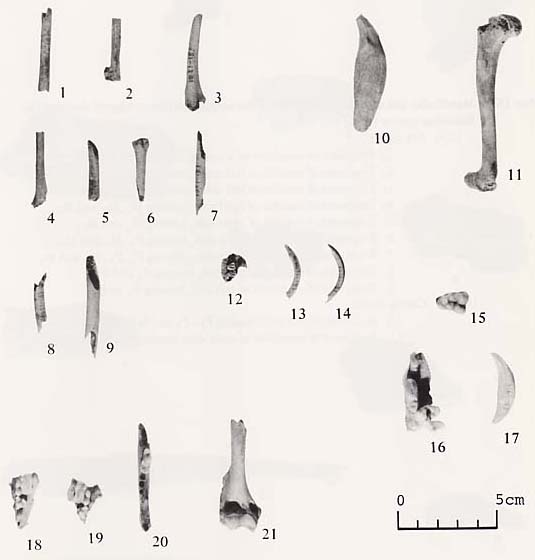
Plate VII: Bird and mammalian bone fragments showing the following species (Scale 1/2).
1-9; Long bones of Phasianus versicolor,
10; Lower right canine of Selenarctos thibetanus,
11; Humerus of Nyctereutes procyonoides,
12-14; Petaurista leucogenys:
12; Fragment of maxilla bearing right M1 and M2,
13; Lower left incisor,
14; Lower right incisor
15-17; Canis famfliaris:
15; Upper left M1,
16; Fragment of maxilla bearing right P3, P4 and M1,
17; Right upper canine
18-21; Meles meles:
18; Fragments of maxilla bearing left P3, P4 and M1,
19; Fragment of maxilla bearing right P4 and M1,
20; Fragment of right mandible bearing M1,
21; Fragment of humerus |
(c) Mammals
Most of the faunal remains are mammalian. The present paper describes only the seven species that were identifiable (Table 5).
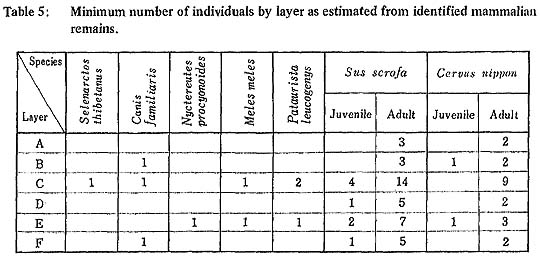
- Selenarctos thibetanus (Cuvier)
- One lower right canine from Layer C (Plate VIII: 10).
- Canis familiaris (Linnaeus)
- An upper left M1 from Layer B (Plate VIII: 15), an upper right canine from Layer (Plate VIII: 17), and a fragment of the right maxilla, bearing P3, P4 and M1, from Layer E (Plate VIII: 16).
- Nyctereutes procyonoides(Gtoy)
- One left humerus from Layer E (Plate VIII: 11).
- Melesmeles (Linnaeus)
- A fragment of the right mandible bearing M1 (Plate VIII:20) and an isolated lower right canine from Layer C; and a fragment of the left maxilla bearing P3,P4 and M1 (Plate VIII: 18), a right maxilla bearing P4 and M1 (Plate VIII: 19), a right mandible, an isolated lower left canine and a left humerus from Layer E (Plate VIII: 21).
- Pataurista leucogenys (Temminck)
- Two incisors from Layer C, a lower left (Plate VIII: 13) and a lower right (Plate VIII: 14) incisor and a fragment of a right maxilla bearing M1 and M2 from Layer E.
- Sus scrofa (Linnaeus)
- This species is the most abundant of the mammals collected (Plate IX: 1-9). At least a few individuals were found in each layer, but they were most common in Layers C and E (Table 3).

Table 3: Total number of the identified teeth of Sus scrofa showing the minimum number of individuals by layer (U: upper, L: lower, r: right, 1: left). |
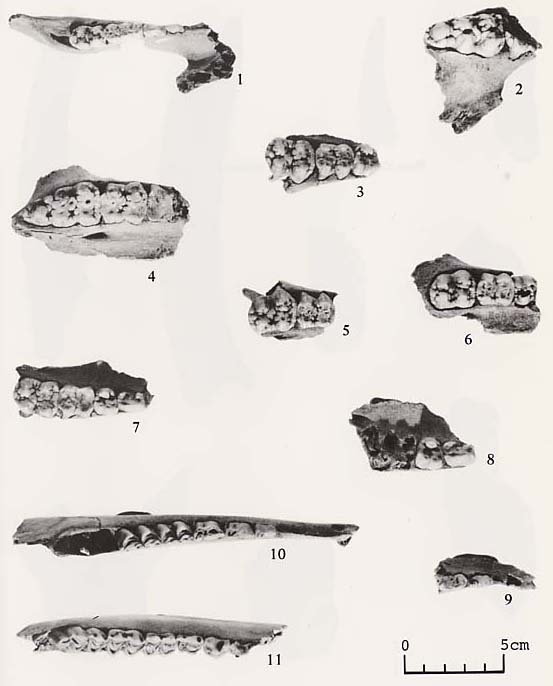
Plate IX: Mandibular and maxillary fragments of Sus scrofa and Cervus nippon showing the following species (Scale 1/2).
1-9; Sus scrofa:
1; Fragment of mandible of a young, bearing left m1 -m4,
2; Fragment of maxilla of left side, bearing M2 and M3,
3; Fragment of maxilla of left side, bearing P4, M1 and M2,
4; Fragment of maxilla of right side, bearing M1, M2 and M3,
5; Fragment of maxilla of right side, bearing M1 and M2,
6; Fragment of maxilla of right side, bearing P4, M1 and M2,
7; Fragment of maxilla of right side, bearing P3,P4, M1 and M2,
8; Fragment of maxilla of left side, bearing P3 and P4,
9; Fragment of mandible of left side, bearing P2 and P3
10-11; Cervus nippon:
10; Mandible of left side, bearing P2 -P4 and M1 -M2,
11; Fragment of mandible of right side, bearing P2 -P4 and M1 -M3 |
- Cervus nippon (Temminck)
- The second most abundant mammalian species (Plate IX:10, 11). A few individuals were found in all layers from A-F but were most common in Layer C (Table 4).

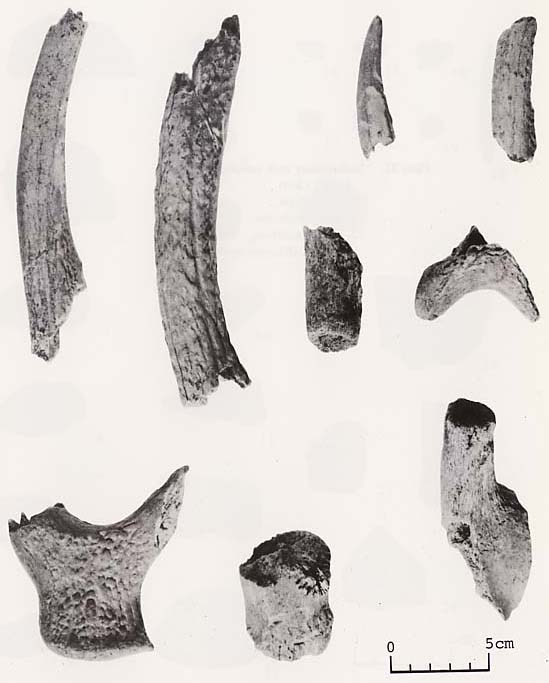
Plate X: Antler of Cervus nippon (Scale 1/2). |
|